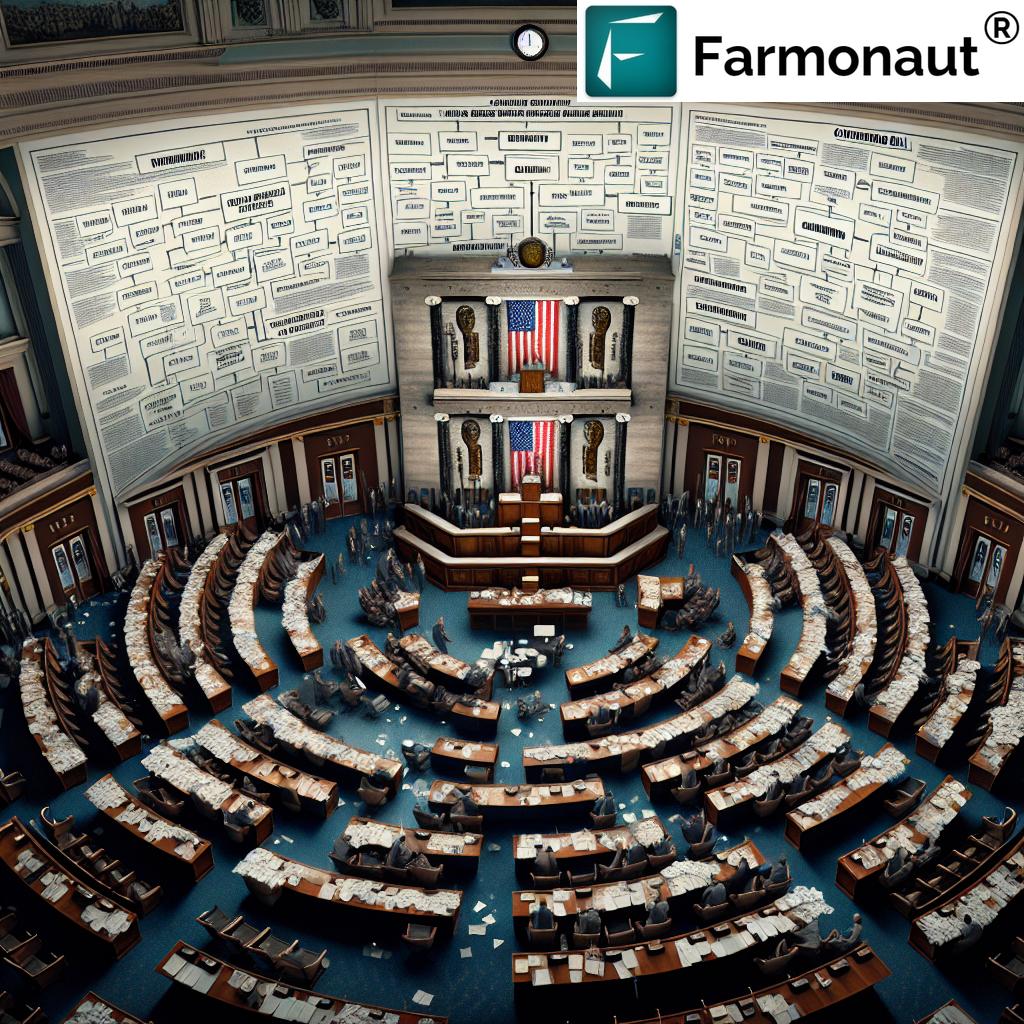Senate Advances Stopgap Spending Bill: Breaking Down the Government Shutdown Debate
As we approach a critical juncture in the U.S. government’s fiscal calendar, the Senate has taken a significant step forward in addressing the looming threat of a partial government shutdown. The advancement of a stopgap spending bill has brought the complex web of federal budget negotiations and congressional appropriations processes into sharp focus. In this comprehensive analysis, we’ll delve into the intricacies of this high-stakes legislative battle and its potential ramifications for the country.

“The U.S. Senate’s procedural vote on the stopgap spending bill affects funding for over 2 million federal employees.”
Understanding the Stopgap Spending Bill
The stopgap spending bill, also known as a continuing resolution (CR), is a temporary measure designed to keep the government funded and operational in the absence of a full budget agreement. This particular CR aims to extend funding through the end of September, effectively covering the remainder of the fiscal year 2025. It’s a crucial piece of legislation that highlights the ongoing challenges in the congressional appropriations process and the broader federal budget negotiations.
Key aspects of the current stopgap spending bill include:
- Extension of funding for all federal agencies and departments
- Continuation of essential government services
- Provisions for critical programs such as veterans’ benefits and housing initiatives
- Temporary resolution of bipartisan spending disagreements
The advancement of this bill in the Senate marks a significant step in averting a partial government shutdown, which could have far-reaching consequences for millions of Americans and the country’s economic stability.
The Senate’s Procedural Vote: A Critical Milestone
The Senate’s recent procedural vote on the stopgap spending bill is a pivotal moment in the ongoing budget negotiations. This vote, requiring a 60-vote majority to limit debate and move forward, demonstrates the complex dynamics at play in the upper chamber of Congress.
Here’s a breakdown of the vote and its implications:
- The procedural vote passed with a 62-38 margin
- It required bipartisan support, highlighting the need for cooperation across party lines
- The vote allows the bill to advance to final consideration, bringing it one step closer to passage
This crucial step in the legislative process underscores the delicate balance of power in the Senate and the importance of bipartisan collaboration in addressing critical national issues.
The Looming Threat of a Government Shutdown
As the deadline for government funding approaches, the specter of a partial government shutdown looms large. A shutdown occurs when Congress fails to pass appropriate funding legislation, leading to a lapse in appropriations for federal agencies and programs.
“A government shutdown could impact operations of more than 400 federal agencies and departments across the nation.”
The potential consequences of a shutdown are far-reaching and include:
- Furloughs for non-essential federal employees
- Disruption of government services and programs
- Potential delays in benefit payments, including Social Security and veterans’ benefits
- Economic ripple effects impacting businesses and communities nationwide
The current debate surrounding the stopgap spending bill is, in essence, a race against time to prevent these dire consequences and ensure the continued functioning of the federal government.

Key Players and Their Positions
The debate over the stopgap spending bill has brought several key political figures to the forefront, each with their own stance on the legislation and broader budgetary issues:
- Senate Majority Leader: Advocating for swift passage of the bill to avert a shutdown
- Senate Minority Leader: Expressing concerns about the bill’s provisions while acknowledging the need to keep the government operational
- House Speaker: Emphasizing the importance of fiscal responsibility and long-term budget solutions
- President: Urging Congress to reach a bipartisan agreement and avoid a government shutdown
These diverse perspectives reflect the complex nature of federal budget negotiations and the challenges of achieving consensus in a divided political landscape.
The Broader Context: Federal Budget Negotiations
The current debate over the stopgap spending bill is part of a larger, ongoing process of federal budget negotiations. These negotiations involve complex discussions about government spending priorities, fiscal responsibility, and the allocation of resources across various agencies and programs.
Key aspects of these broader negotiations include:
- Debates over discretionary spending levels
- Discussions about entitlement program funding
- Considerations of national defense and domestic program priorities
- Long-term fiscal planning and deficit reduction strategies
The stopgap spending bill serves as a temporary solution while these larger budgetary issues continue to be debated and negotiated in Congress.
Impact on Federal Employees and Government Services
One of the most immediate and tangible effects of the current budget situation is its impact on federal employees and the services they provide. The uncertainty surrounding government funding can have significant consequences for the workforce and the millions of Americans who rely on government programs and services.
Potential impacts include:
- Uncertainty for federal workers regarding job security and pay
- Possible disruptions to essential services in various sectors
- Delays in processing applications, permits, and other government documents
- Strain on local economies heavily dependent on federal employment
The advancement of the stopgap spending bill aims to mitigate these potential disruptions and provide some stability for federal employees and the services they deliver.
The Role of Bipartisanship in Budget Negotiations
The current situation underscores the critical importance of bipartisan cooperation in addressing national fiscal challenges. The need for a 60-vote majority in the Senate to advance legislation like the stopgap spending bill necessitates collaboration across party lines.
Key aspects of bipartisanship in this context include:
- Finding common ground on spending priorities
- Negotiating compromises on contentious budget issues
- Working together to avoid government shutdowns and fiscal crises
- Balancing diverse constituent interests with national needs
The success or failure of these bipartisan efforts can have far-reaching consequences for the country’s fiscal health and the stability of government operations.
Looking Ahead: Long-Term Budget Solutions
While the stopgap spending bill addresses immediate funding needs, it also highlights the need for more comprehensive, long-term budget solutions. Policymakers and experts are increasingly calling for reforms to the budget process to avoid recurring crises and promote fiscal stability.
Potential long-term solutions being discussed include:
- Reforms to the appropriations process to ensure timely passage of funding bills
- Implementation of multi-year budgeting frameworks
- Increased focus on long-term fiscal planning and deficit reduction
- Exploration of bipartisan budget enforcement mechanisms
These discussions reflect a growing recognition of the need for systemic changes to address the recurring challenges in federal budget negotiations.
Conclusion: The Path Forward
As the Senate advances the stopgap spending bill, the nation watches closely to see how this critical piece of legislation will fare in the final stages of the congressional process. The outcome of this debate will have immediate implications for government operations, federal employees, and the millions of Americans who depend on government services.
Moreover, this situation serves as a stark reminder of the ongoing challenges in our federal budget process and the need for long-term, bipartisan solutions to ensure fiscal stability and effective governance. As we move forward, it’s clear that addressing these fundamental issues will require continued dialogue, compromise, and a shared commitment to the nation’s fiscal health.
The coming days and weeks will be crucial in determining not only the immediate fate of government funding but also in shaping the broader conversation about how we, as a nation, approach the complex task of budgeting for our collective future.
FAQ Section
Q: What is a stopgap spending bill?
A: A stopgap spending bill, also known as a continuing resolution (CR), is a temporary measure to fund the government when a full budget hasn’t been passed. It typically maintains current spending levels for a set period.
Q: How does a government shutdown affect federal employees?
A: During a shutdown, non-essential federal employees are furloughed without pay, while essential employees must work without immediate compensation. All affected employees typically receive back pay once funding is restored.
Q: What services are impacted during a government shutdown?
A: A shutdown can affect various services, including national parks, passport processing, some food inspections, and certain financial services. Essential services like national security and air traffic control continue to operate.
Q: How long can a stopgap spending bill last?
A: The duration varies. This current bill aims to fund the government through September, but CRs can last for shorter periods, sometimes just a few weeks, depending on the agreement reached in Congress.
Q: What happens if the stopgap spending bill doesn’t pass?
A: If the bill doesn’t pass before the current funding expires, the government will enter a partial shutdown, leading to the suspension of non-essential services and furloughs for many federal employees.
Earn With Farmonaut: Affiliate Program
Earn 20% recurring commission with Farmonaut’s affiliate program by sharing your promo code and helping farmers save 10%. Onboard 10 Elite farmers monthly to earn a minimum of $148,000 annually—start now and grow your income!
For more information on Farmonaut’s innovative agricultural solutions:
| Date | Event | Significance |
|---|---|---|
| March 1, 2025 | Initial proposal of stopgap spending bill | Marks the beginning of the current funding debate |
| March 10, 2025 | House passes stopgap bill | Advances the bill to the Senate for consideration |
| March 15, 2025 | Senate procedural vote | Clears way for final Senate vote on the bill |
| March 18, 2025 | Current funding deadline | Date by which new funding must be approved to avoid shutdown |
| September 30, 2025 | End of fiscal year | Deadline for full-year budget agreement |




